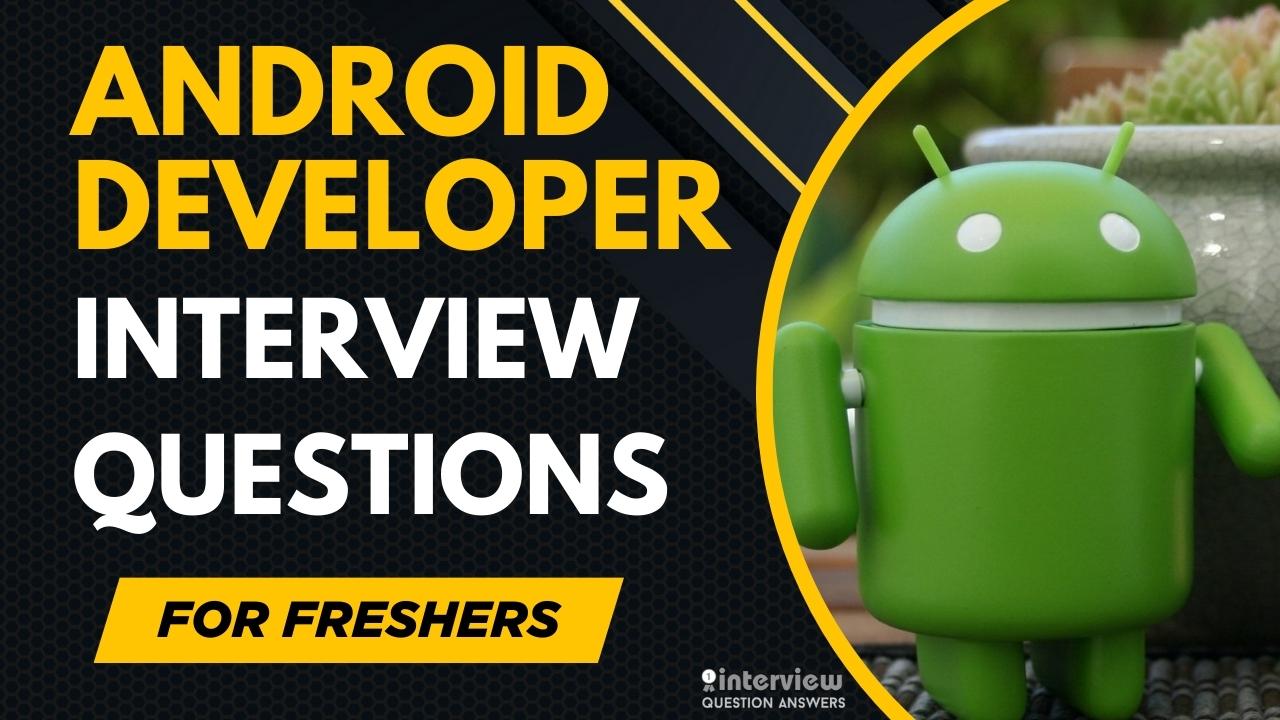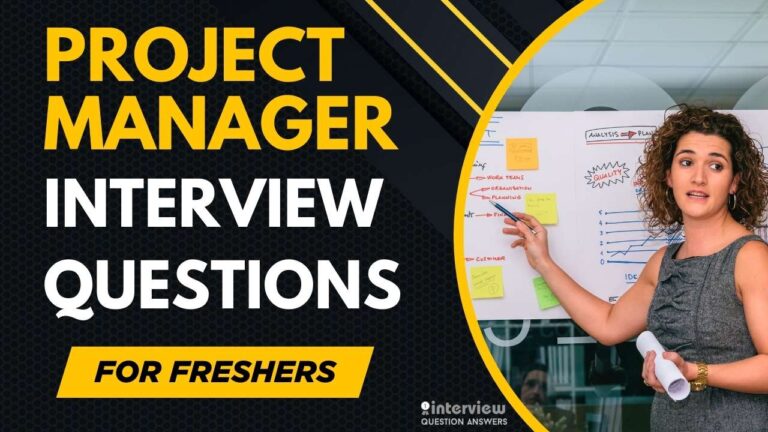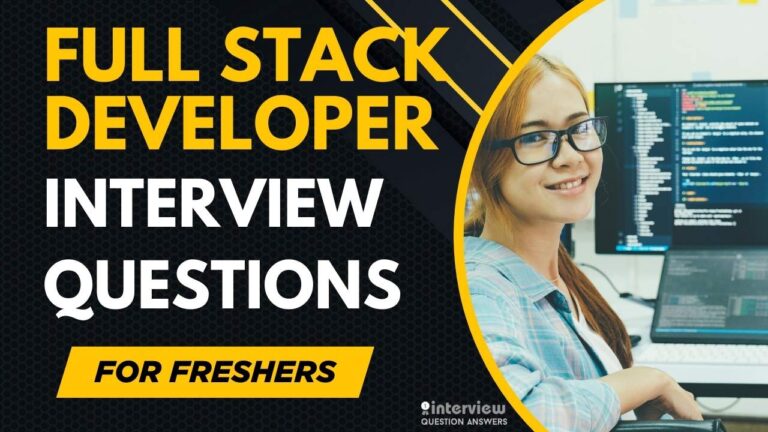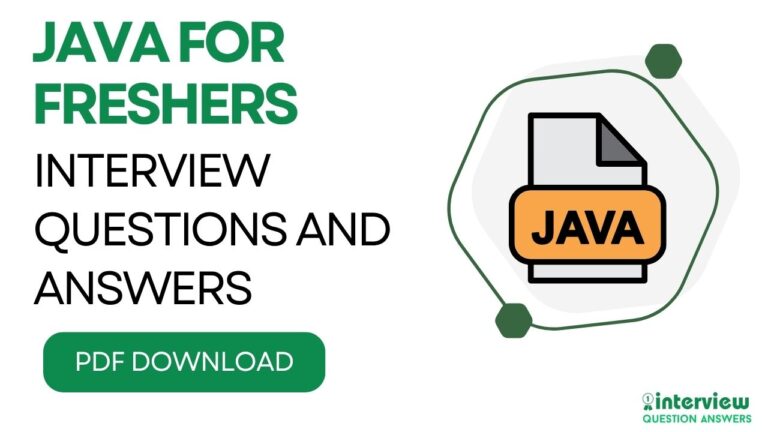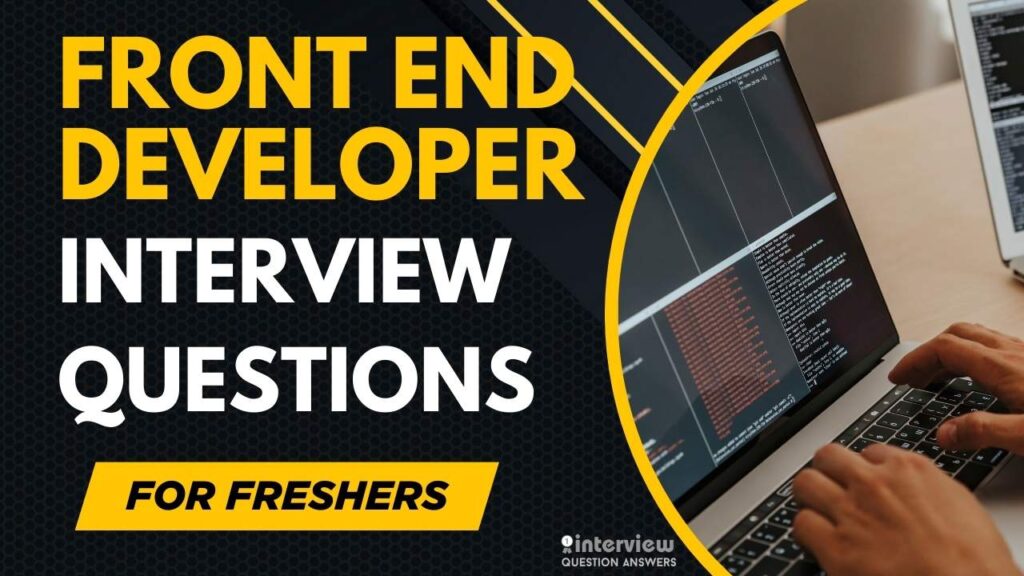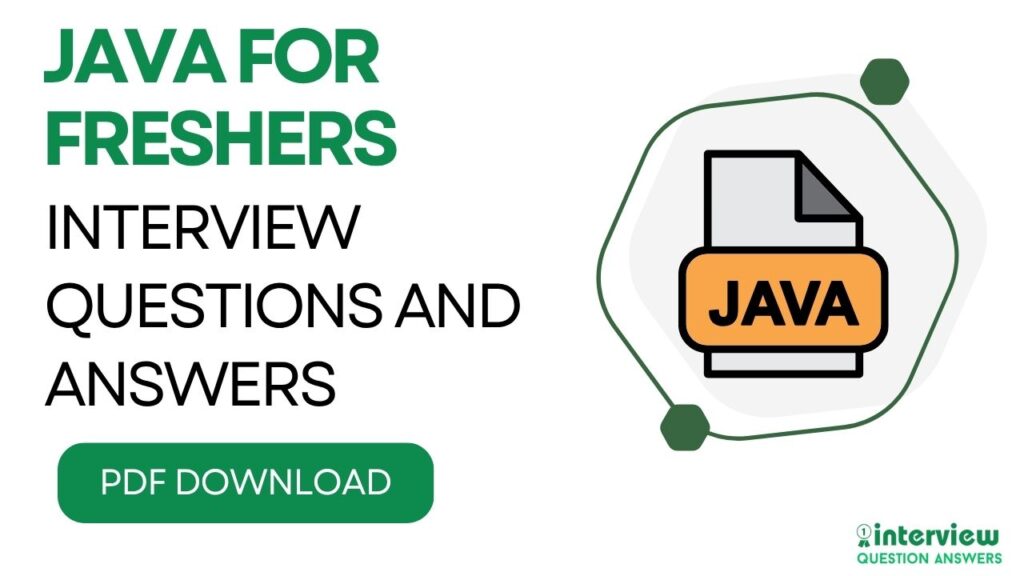Top 60 Android Developer Interview Questions for Freshers
Preparing for Android Developer interviews as a fresher? We’ve got you covered. This guide on Android Developer Interview Questions for Freshers brings together a comprehensive collection of both basic and advanced questions to help you build confidence before facing interviews.
This guide helps you master core Android concepts like Activities, Fragments, and Intents and explore advanced areas such as Kotlin, Jetpack Libraries, and app performance optimization. It prepares you for both fundamental and scenario-based questions.
Use this guide to strengthen your concepts, practice problem-solving, and stay ahead in your Android development career journey.
You can also check our another detailed article: Top 100 Android Developer Interview Questions PDF
Table of Contents
Entry Level Android Developer Interview Questions
Que 1. What is the role of an Android developer in building a mobile application?
Answer:
An Android developer designs, builds, and maintains mobile applications for the Android platform using Java or Kotlin. They create user interfaces, implement functionality, connect to APIs, and ensure app performance and compatibility across devices.
Que 2. What is an Activity in Android, and what is its purpose?
Answer:
An Activity is a single screen with a user interface in an Android app, managed by the Activity class. It handles user interactions and lifecycle events like onCreate() and onDestroy().
class MainActivity : AppCompatActivity() {
override fun onCreate(savedInstanceState: Bundle?) {
super.onCreate(savedInstanceState)
setContentView(R.layout.activity_main)
}
}Que 3. What is the difference between LinearLayout and ConstraintLayout?
Answer:LinearLayout arranges views in a single direction (horizontal or vertical) and is simpler but less flexible. ConstraintLayout allows complex layouts with constraints, offering more control and adaptability for responsive designs.
<androidx.constraintlayout.widget.ConstraintLayout
android:layout_width="match_parent"
android:layout_height="match_parent">
<Button
android:layout_width="wrap_content"
android:layout_height="wrap_content"
app:layout_constraintTop_toTopOf="parent"
app:layout_constraintStart_toStartOf="parent" />
</androidx.constraintlayout.widget.ConstraintLayout>Que 4. How do you handle button clicks in an Android app?
Answer:
Use setOnClickListener on a Button to handle click events, executing logic in the callback.
class MainActivity : AppCompatActivity() {
override fun onCreate(savedInstanceState: Bundle?) {
super.onCreate(savedInstanceState)
setContentView(R.layout.activity_main)
findViewById<Button>(R.id.myButton).setOnClickListener {
Toast.makeText(this, "Button clicked", Toast.LENGTH_SHORT).show()
}
}
}Que 5. What is the Android Manifest file, and what is its purpose?
Answer:
The AndroidManifest.xml file defines an app’s structure, permissions, activities, and configurations. It’s required for the app to run and informs the system about the app’s components.
<manifest xmlns:android="http://schemas.android.com/apk/res/android">
<application>
<activity android:name=".MainActivity">
<intent-filter>
<action android:name="android.intent.action.MAIN" />
<category android:name="android.intent.category.LAUNCHER" />
</intent-filter>
</activity>
</application>
</manifest>Que 6. What is the difference between dp, sp, and px in Android layouts?
Answer:dp (density-independent pixels) adapts to screen density for consistent sizing. sp (scale-independent pixels) is similar but also scales with user font preferences, used for text. px (pixels) is absolute and not recommended for responsive designs.
<TextView
android:layout_width="100dp"
android:layout_height="wrap_content"
android:textSize="16sp" />Que 7. How do you fetch data from an API in an Android app?
Answer:
Use libraries like Retrofit or OkHttp to make HTTP requests. Parse JSON responses with Gson and handle asynchronously with coroutines or callbacks.
// Retrofit example
interface ApiService {
@GET("users")
suspend fun getUsers(): List<User>
}
val retrofit = Retrofit.Builder()
.baseUrl("https://api.example.com/")
.build()
val service = retrofit.create(ApiService::class.java)Que 8. What is the purpose of Intent in Android?
Answer:
An Intent is a messaging object used to start activities, services, or broadcast events. It facilitates navigation between screens or communication between components.
val intent = Intent(this, SecondActivity::class.java)
intent.putExtra("key", "value")
startActivity(intent)Que 9. What is the Android activity lifecycle, and why is it important?
Answer:
The activity lifecycle includes methods like onCreate(), onStart(), onResume(), onPause(), onStop(), and onDestroy(). It’s important for managing resources, saving state, and ensuring smooth user experience during configuration changes.
Que 10. How do you create a RecyclerView to display a list in Android?
Answer:
Use RecyclerView with an adapter to display dynamic lists. Define a layout for list items, create an adapter, and bind it to the RecyclerView.
class MyAdapter(private val items: List<String>) : RecyclerView.Adapter<MyViewHolder>() {
override fun onCreateViewHolder(parent: ViewGroup, viewType: Int): MyViewHolder {
val view = LayoutInflater.from(parent.context).inflate(R.layout.item_layout, parent, false)
return MyViewHolder(view)
}
override fun onBindViewHolder(holder: MyViewHolder, position: Int) {
holder.textView.text = items[position]
}
override fun getItemCount(): Int = items.size
}
class MyViewHolder(view: View) : RecyclerView.ViewHolder(view) {
val textView: TextView = view.findViewById(R.id.textView)
}Que 11. What is the purpose of the build.gradle file in an Android project?
Answer:
The build.gradle file configures the build process, specifying dependencies, SDK versions, and app settings for Gradle to compile the app.
android {
compileSdk 33
defaultConfig {
minSdk 21
targetSdk 33
}
}
dependencies {
implementation 'androidx.core:core-ktx:1.9.0'
}Que 12. How do you handle screen orientation changes in Android?
Answer:
Save instance state in onSaveInstanceState() and restore in onCreate(). Alternatively, use ViewModel to persist data or lock orientation in the manifest.
override fun onSaveInstanceState(outState: Bundle) {
super.onSaveInstanceState(outState)
outState.putString("key", "value")
}
override fun onCreate(savedInstanceState: Bundle?) {
super.onCreate(savedInstanceState)
savedInstanceState?.getString("key")?.let { /* Restore */ }
}Que 13. What is the difference between a Fragment and an Activity?
Answer:
An Activity is a single screen, while a Fragment is a modular UI component that can be embedded within an Activity. Fragments allow reusable UI and better handling of complex layouts.
class MyFragment : Fragment() {
override fun onCreateView(inflater: LayoutInflater, container: ViewGroup?, savedInstanceState: Bundle?): View? {
return inflater.inflate(R.layout.fragment_layout, container, false)
}
}Que 14. How do you request runtime permissions in Android?
Answer:
Use ActivityCompat.requestPermissions() for permissions like location or camera, handling user responses in onRequestPermissionsResult().
if (ContextCompat.checkSelfPermission(this, Manifest.permission.CAMERA) != PackageManager.PERMISSION_GRANTED) {
ActivityCompat.requestPermissions(this, arrayOf(Manifest.permission.CAMERA), 100)
}
override fun onRequestPermissionsResult(requestCode: Int, permissions: Array<String>, grantResults: IntArray) {
if (requestCode == 100 && grantResults[0] == PackageManager.PERMISSION_GRANTED) {
// Permission granted
}
}Que 15. What is the purpose of SharedPreferences in Android?
Answer:SharedPreferences stores small key-value pairs (e.g., user settings) persistently in XML files, accessible across app sessions.
val prefs = getSharedPreferences("myPrefs", MODE_PRIVATE)
prefs.edit().putString("username", "John").apply()
val username = prefs.getString("username", "")Que 16. How do you create a simple layout in XML for an Android app?
Answer:
Use XML to define UI components like buttons and text fields, specifying attributes like size and position.
<LinearLayout
android:layout_width="match_parent"
android:layout_height="match_parent"
android:orientation="vertical">
<TextView
android:layout_width="wrap_content"
android:layout_height="wrap_content"
android:text="Hello, Android!" />
</LinearLayout>Que 17. What is the difference between match_parent and wrap_content in Android layouts?
Answer:match_parent makes a view as large as its parent allows. wrap_content sizes the view to fit its content, like text or an image.
<Button
android:layout_width="match_parent"
android:layout_height="wrap_content"
android:text="Click Me" />Que 18. How do you debug an Android application?
Answer:
Use Android Studio’s Logcat for logs, set breakpoints in code, and inspect variables. Test on emulators or real devices, and use Log.d() for debug messages.
Log.d("MyApp", "Debug message")Que 19. What is an Intent Filter in Android?
Answer:
An Intent Filter in the manifest declares which intents an Activity or component can handle, like launching the app or responding to specific actions.
<activity android:name=".MainActivity">
<intent-filter>
<action android:name="android.intent.action.VIEW" />
<category android:name="android.intent.category.DEFAULT" />
<data android:scheme="http" />
</intent-filter>
</activity>Que 20. How do you make an HTTP POST request in Android?
Answer:
Use Retrofit with a POST method to send data to a server, handling JSON responses with coroutines for async execution.
interface ApiService {
@POST("users")
suspend fun createUser(@Body user: User): Response<User>
}
val retrofit = Retrofit.Builder()
.baseUrl("https://api.example.com/")
.build()
val service = retrofit.create(ApiService::class.java)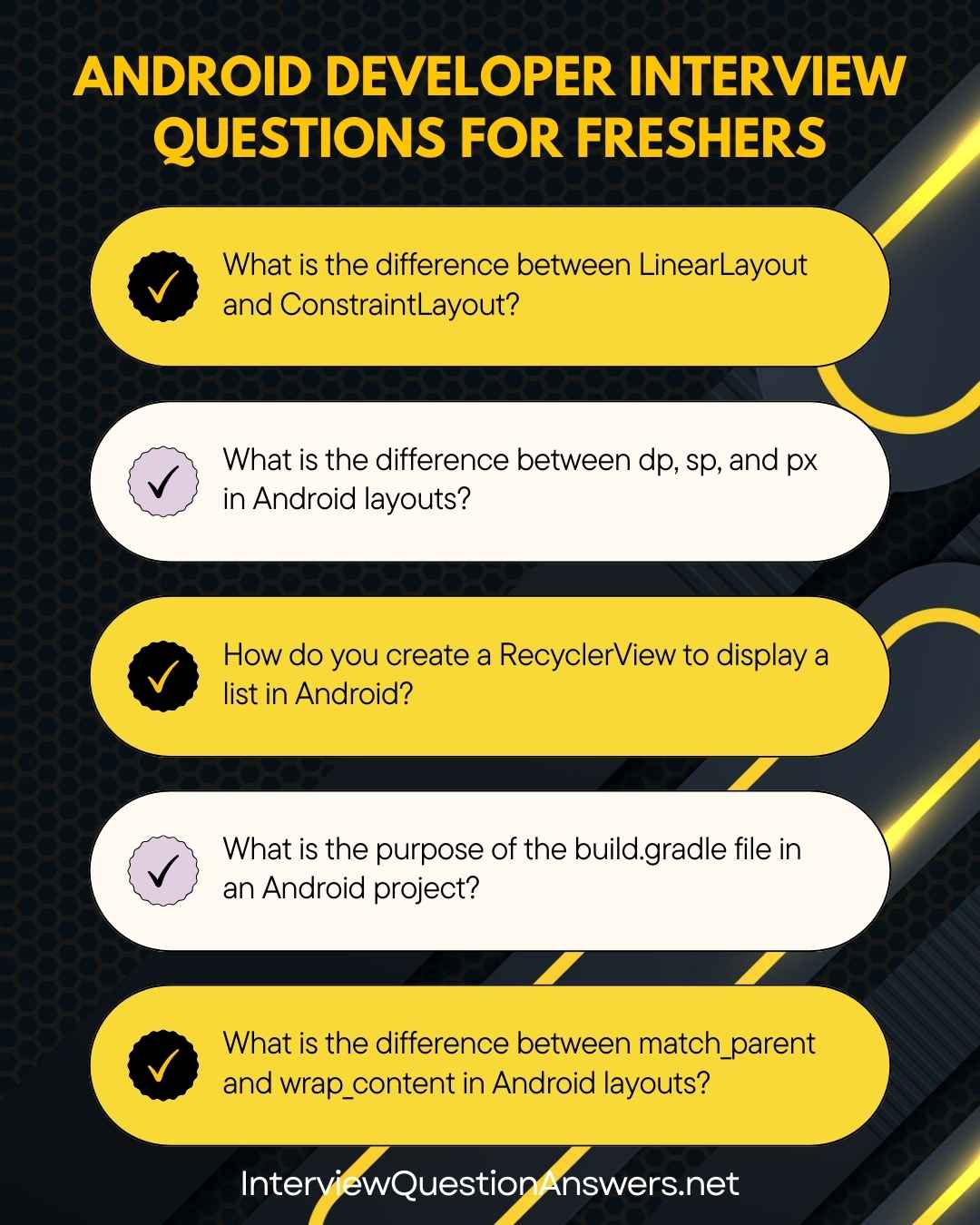
Also Check: Android Developer Interview Questions for Experienced
Basic Android Developer Interview Questions for Freshers
Que 21. What is the purpose of the res folder in an Android project?
Answer:
The res folder contains resources like layouts, drawables, strings, and other assets used in the app. It organizes non-code files that Android Studio compiles into the app, such as XML layouts and images.
Que 22. How do you display a Toast message in an Android app?
Answer:
Use the Toast class to show a short-lived message to the user, specifying the context, message, and duration.
Toast.makeText(this, "Hello, Android!", Toast.LENGTH_SHORT).show()Que 23. What is the difference between findViewById() and View Binding in Android?
Answer:findViewById() retrieves views by ID but is prone to null errors. View Binding generates type-safe binding classes, improving safety and reducing boilerplate.
// View Binding
private lateinit var binding: ActivityMainBinding
override fun onCreate(savedInstanceState: Bundle?) {
super.onCreate(savedInstanceState)
binding = ActivityMainBinding.inflate(layoutInflater)
setContentView(binding.root)
binding.textView.text = "Hello"
}Que 24. How do you start a new Activity in Android?
Answer:
Create an Intent with the target Activity class and call startActivity() to launch it.
val intent = Intent(this, SecondActivity::class.java)
startActivity(intent)Que 25. What is the purpose of the strings.xml file in Android?
Answer:
The strings.xml file stores string resources for localization and reusability, allowing easy updates and translations without changing code.
<resources>
<string name="app_name">My App</string>
<string name="welcome">Welcome!</string>
</resources>Que 26. How do you add a click listener to a View in Android?
Answer:
Use setOnClickListener on a View to handle click events, or define android:onClick in XML for simpler cases.
findViewById<Button>(R.id.button).setOnClickListener {
// Handle click
}<Button
android:layout_width="wrap_content"
android:layout_height="wrap_content"
android:onClick="onButtonClick" />fun onButtonClick(view: View) {
// Handle click
}Que 27. What is the difference between Activity and Fragment in Android?
Answer:
An Activity is a single screen with a user interface, while a Fragment is a reusable UI component within an Activity, allowing modular and flexible layouts.
Que 28. How do you define a layout in XML for an Android app?
Answer:
Use XML to create layouts in the res/layout folder, specifying views and their properties.
<LinearLayout
android:layout_width="match_parent"
android:layout_height="match_parent"
android:orientation="vertical">
<TextView
android:layout_width="wrap_content"
android:layout_height="wrap_content"
android:text="@string/welcome" />
</LinearLayout>Que 29. What is the purpose of R class in Android?
Answer:
The R class is auto-generated by Android Studio, providing references to resources (e.g., layouts, strings, IDs) for use in code.
setContentView(R.layout.activity_main)
findViewById<TextView>(R.id.textView)Que 30. How do you handle user input from an EditText in Android?
Answer:
Retrieve text from an EditText using its text property and process it as needed.
val editText = findViewById<EditText>(R.id.editText)
val input = editText.text.toString()Que 31. What is the purpose of minSdk and targetSdk in build.gradle?
Answer:minSdk specifies the minimum Android version the app supports. targetSdk indicates the version the app is optimized for, ensuring compatibility and feature usage.
android {
defaultConfig {
minSdk 21
targetSdk 33
}
}Que 32. How do you display an image in an Android app?
Answer:
Use an ImageView with a drawable resource or URL, specifying the source in XML or code.
<ImageView
android:layout_width="100dp"
android:layout_height="100dp"
android:src="@drawable/my_image" />Que 33. What is the difference between dp and px in Android?
Answer:dp (density-independent pixels) adjusts for screen density, ensuring consistent sizing across devices. px (pixels) is absolute and varies by device resolution, not recommended for layouts.
Que 34. How do you save data in SharedPreferences?
Answer:
Use SharedPreferences to store key-value pairs persistently, accessing with getSharedPreferences() and editing with edit().
val prefs = getSharedPreferences("myPrefs", MODE_PRIVATE)
prefs.edit().putString("key", "value").apply()Que 35. What is an Intent Filter, and how is it used?
Answer:
An Intent Filter in the manifest specifies which intents an Activity can handle, like launching the app or responding to specific data types.
<activity android:name=".MainActivity">
<intent-filter>
<action android:name="android.intent.action.MAIN" />
<category android:name="android.intent.category.LAUNCHER" />
</intent-filter>
</activity>Que 36. How do you create a simple ListView in Android?
Answer:
Use a ListView with an ArrayAdapter to display a list of items, binding data to a layout.
val listView = findViewById<ListView>(R.id.listView)
val adapter = ArrayAdapter(this, android.R.layout.simple_list_item_1, listOf("Item 1", "Item 2"))
listView.adapter = adapterQue 37. What is the role of onCreate() in an Android Activity?
Answer:onCreate() is called when an Activity is created, used to initialize the UI, set up views, and load initial data.
override fun onCreate(savedInstanceState: Bundle?) {
super.onCreate(savedInstanceState)
setContentView(R.layout.activity_main)
}Que 38. How do you request a permission in Android?
Answer:
Use ActivityCompat.requestPermissions() for runtime permissions (e.g., camera), handling results in onRequestPermissionsResult().
ActivityCompat.requestPermissions(this, arrayOf(Manifest.permission.CAMERA), 100)Que 39. What is the purpose of the AndroidManifest.xml file?
Answer:
The AndroidManifest.xml declares the app’s components (Activities, Services), permissions, and configurations, serving as the entry point for the Android system.
Que 40. How do you handle a configuration change like screen rotation?
Answer:
Save state in onSaveInstanceState() and restore in onCreate(). Alternatively, use ViewModel to persist data or lock orientation in the manifest.
override fun onSaveInstanceState(outState: Bundle) {
super.onSaveInstanceState(outState)
outState.putString("data", "value")
}Advanced Android Developer Interview Questions for Freshers
Que 41. How do you implement dependency injection in an Android application?
Answer:
Use Dagger or Hilt for dependency injection to manage dependencies and improve testability. Define modules to provide dependencies and inject them into Activities or ViewModels.
// Hilt example
@Module
@InstallIn(SingletonComponent::class)
object AppModule {
@Provides
fun provideApiService(): ApiService = Retrofit.Builder()
.baseUrl("https://api.example.com/")
.build()
.create(ApiService::class.java)
}
@HiltViewModel
class MyViewModel @Inject constructor(private val apiService: ApiService) : ViewModel()Que 42. How do you optimize an Android app for battery efficiency?
Answer:
Minimize background processes, use JobScheduler or WorkManager for deferred tasks, and optimize network calls with batching. Avoid wakelocks, use Doze mode-friendly scheduling, and monitor with Battery Historian.
// WorkManager example
val workRequest = OneTimeWorkRequestBuilder<MyWorker>()
.setConstraints(Constraints.Builder().setRequiresBatteryNotLow(true).build())
.build()
WorkManager.getInstance(context).enqueue(workRequest)Que 43. How do you handle network calls in an Android app using Retrofit and Coroutines?
Answer:
Use Retrofit with Kotlin Coroutines for asynchronous network calls. Define an API interface, handle responses in a ViewModel, and update the UI on the main thread.
interface ApiService {
@GET("users")
suspend fun getUsers(): List<User>
}
@HiltViewModel
class UserViewModel @Inject constructor(private val apiService: ApiService) : ViewModel() {
fun fetchUsers() = viewModelScope.launch {
val users = apiService.getUsers()
// Update UI
}
}Que 44. What is the role of ViewModel in Android, and how does it handle configuration changes?
Answer:
ViewModel stores UI-related data, surviving configuration changes like screen rotations. It separates data logic from the UI, scoped to an Activity or Fragment lifecycle.
class MyViewModel : ViewModel() {
private val _data = MutableLiveData<String>()
val data: LiveData<String> get() = _data
fun loadData() { _data.value = "Loaded" }
}Que 45. How do you implement a custom View in Android?
Answer:
Extend View or ViewGroup, override onDraw() for rendering, and handle touch events in onTouchEvent(). Define custom attributes in XML for reusability.
class CustomView(context: Context, attrs: AttributeSet?) : View(context, attrs) {
override fun onDraw(canvas: Canvas) {
super.onDraw(canvas)
canvas.drawCircle(100f, 100f, 50f, Paint().apply { color = Color.RED })
}
}Que 46. How do you secure sensitive data in an Android app?
Answer:
Encrypt data with EncryptedSharedPreferences or Jetpack Security. Store keys in Android Keystore, use HTTPS for network calls, and obfuscate code with ProGuard or R8.
val masterKey = MasterKey.Builder(context).setKeyScheme(MasterKey.KeyScheme.AES256_GCM).build()
val prefs = EncryptedSharedPreferences.create(context, "secure_prefs", masterKey, AES256_SIV, AES256_GCM)
prefs.edit().putString("key", "secret").apply()Que 47. How do you implement navigation in an Android app using Jetpack Navigation?
Answer:
Use Jetpack Navigation with a NavController and navigation graph to manage Fragment transitions. Define destinations and actions in XML and navigate programmatically.
<!-- nav_graph.xml -->
<navigation xmlns:android="http://schemas.android.com/apk/res/android">
<fragment android:id="@+id/homeFragment" android:name=".HomeFragment">
<action android:id="@+id/action_to_details" app:destination="@id/detailsFragment" />
</fragment>
<fragment android:id="@+id/detailsFragment" android:name=".DetailsFragment" />
</navigation>findNavController().navigate(R.id.action_to_details)Que 48. How do you handle background tasks in Android?
Answer:
Use WorkManager for deferrable, guaranteed tasks like syncing data. Configure constraints (e.g., network availability) and chain tasks for complex workflows.
val workRequest = PeriodicWorkRequestBuilder<MyWorker>(15, TimeUnit.MINUTES)
.setConstraints(Constraints.Builder().setRequiredNetworkType(NetworkType.CONNECTED).build())
.build()
WorkManager.getInstance(context).enqueue(workRequest)Que 49. How do you optimize RecyclerView performance in an Android app?
Answer:
Use ViewHolder pattern, enable setHasStableIds() for stable IDs, and implement DiffUtil for efficient list updates. Cache views and avoid heavy computations in onBindViewHolder.
class MyAdapter : ListAdapter<String, MyViewHolder>(DiffCallback()) {
override fun onCreateViewHolder(parent: ViewGroup, viewType: Int): MyViewHolder {
val view = LayoutInflater.from(parent.context).inflate(R.layout.item, parent, false)
return MyViewHolder(view)
}
override fun onBindViewHolder(holder: MyViewHolder, position: Int) {
holder.bind(getItem(position))
}
}
class DiffCallback : DiffUtil.ItemCallback<String>() {
override fun areItemsTheSame(oldItem: String, newItem: String) = oldItem == newItem
override fun areContentsTheSame(oldItem: String, newItem: String) = oldItem == newItem
}Que 50. How do you implement unit testing in an Android app?
Answer:
Use JUnit for unit tests and Mockito for mocking dependencies. Test ViewModels and business logic, running tests on the JVM for speed.
@Test
fun testViewModel() {
val viewModel = MyViewModel(mockApiService)
viewModel.loadData()
assertEquals("Loaded", viewModel.data.value)
}Que 51. How do you handle different screen sizes and densities in Android?
Answer:
Use dp for layouts, provide alternative resources (e.g., layout-sw600dp for tablets), and use ConstraintLayout for flexible designs. Test on multiple emulators and devices.
<!-- res/layout-sw600dp/main_activity.xml -->
<ConstraintLayout
android:layout_width="match_parent"
android:layout_height="match_parent">
<!-- Adjusted layout for larger screens -->
</ConstraintLayout>Que 52. What is the role of Room persistence library in Android?
Answer:
Room provides an abstraction layer over SQLite, enabling type-safe database access with annotations like @Entity and @Dao. It supports LiveData and coroutines for reactive queries.
@Entity
data class User(@PrimaryKey val id: Int, val name: String)
@Dao
interface UserDao {
@Query("SELECT * FROM user")
suspend fun getAll(): List<User>
}
@Database(entities = [User::class], version = 1)
abstract class AppDatabase : RoomDatabase() {
abstract fun userDao(): UserDao
}Que 53. How do you implement push notifications in an Android app?
Answer:
Use Firebase Cloud Messaging (FCM) to send push notifications. Register the app with FCM, handle tokens, and process messages in a FirebaseMessagingService.
class MyFirebaseMessagingService : FirebaseMessagingService() {
override fun onMessageReceived(message: RemoteMessage) {
// Handle notification
showNotification(message.notification?.body)
}
}Que 54. How do you handle memory leaks in an Android app?
Answer:
Use LeakCanary to detect leaks, avoid holding references to Activities in static fields, and clean up observers in ViewModels. Use onCleared() in ViewModel and profile with Android Studio’s Profiler.
class MyViewModel : ViewModel() {
override fun onCleared() {
// Clean up resources
super.onCleared()
}
}Que 55. How do you implement a REST API call with error handling in Android?
Answer:
Use Retrofit with coroutines for API calls, wrapping responses in a sealed class to handle success, error, and loading states.
sealed class Result<out T> {
data class Success<out T>(val data: T) : Result<T>()
data class Error(val exception: Exception) : Result<Nothing>()
}
class MyViewModel : ViewModel() {
fun fetchData() = viewModelScope.launch {
try {
val data = apiService.getUsers()
// Handle success
} catch (e: Exception) {
// Handle error
}
}
}Que 56. How do you use LiveData in an Android app?
Answer:
LiveData is an observable data holder that respects the Activity/Fragment lifecycle. Use it in ViewModel to update the UI reactively.
class MyViewModel : ViewModel() {
private val _data = MutableLiveData<String>()
val data: LiveData<String> get() = _data
fun loadData() { _data.value = "Updated" }
}Que 57. How do you implement navigation with safe args in Jetpack Navigation?
Answer:
Use safe args in the navigation graph to pass type-safe arguments between destinations, generating helper classes for navigation.
<!-- nav_graph.xml -->
<fragment android:id="@+id/homeFragment">
<action android:id="@+id/action_to_details" app:destination="@id/detailsFragment">
<argument android:name="userId" app:argType="integer" />
</action>
</fragment>val action = HomeFragmentDirections.actionToDetails(userId = 123)
findNavController().navigate(action)Que 58. How do you handle large datasets in a RecyclerView?
Answer:
Use Paging Library to load data incrementally, reducing memory usage. Combine with Room or Retrofit for efficient data fetching.
val pagingSource = object : PagingSource<Int, User>() {
override suspend fun load(params: LoadParams<Int>): LoadResult<Int, User> {
val page = params.key ?: 1
val users = apiService.getUsers(page)
return LoadResult.Page(users, prevKey = if (page == 1) null else page - 1, nextKey = page + 1)
}
}Que 59. How do you implement dark mode in an Android app?
Answer:
Use AppCompatDelegate to toggle dark mode, provide theme resources in res/values-night, and test with forceDarkAllowed.
<!-- res/values/themes.xml -->
<style name="AppTheme" parent="Theme.AppCompat.Light.DarkActionBar">
<!-- Light theme -->
</style>
<!-- res/values-night/themes.xml -->
<style name="AppTheme" parent="Theme.AppCompat.DayNight">
<!-- Dark theme -->
</style>AppCompatDelegate.setDefaultNightMode(AppCompatDelegate.MODE_NIGHT_YES)Que 60. How do you test an Android app for compatibility across devices?
Answer:
Test on emulators with different API levels and screen sizes, use Firebase Test Lab for real-device testing, and check layouts with ConstraintLayout. Monitor crashes with Crashlytics.
// Crashlytics
FirebaseCrashlytics.getInstance().recordException(exception)Conclusion
We have already shared the questions for Android Developer Interview Questions for Freshers, covering both basic and advanced questions to help you prepare thoroughly.
With the rising demand for skilled Android developers driven by the booming mobile app industry, staying updated on the latest tools, frameworks, and trends like Jetpack Compose, Kotlin Multiplatform, and AI-powered mobile solutions can give you a competitive edge.
This Android Developer Interview Questions for Freshers Guide includes a well-curated set of questions that can help you build strong foundational knowledge as well as tackle challenging scenarios asked in interviews.
Similar Interview Guide:

